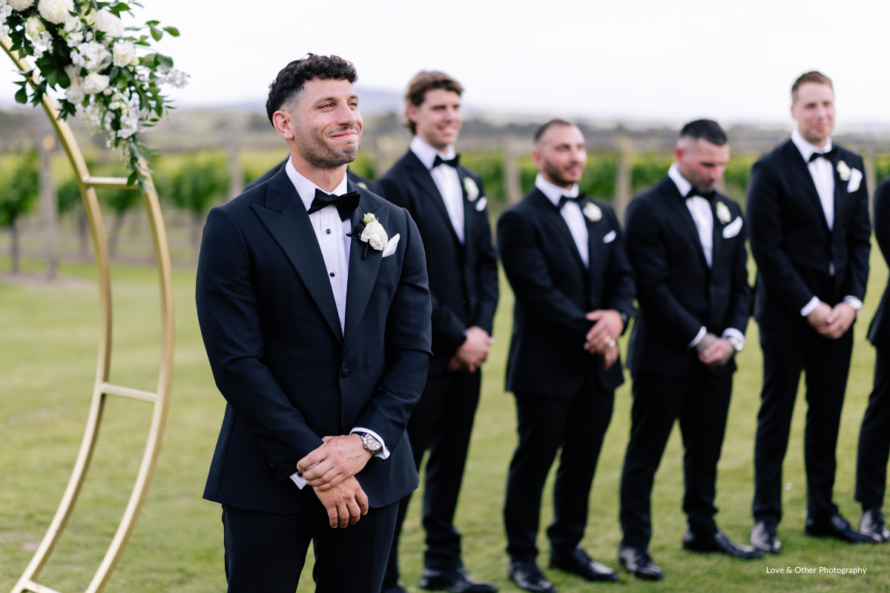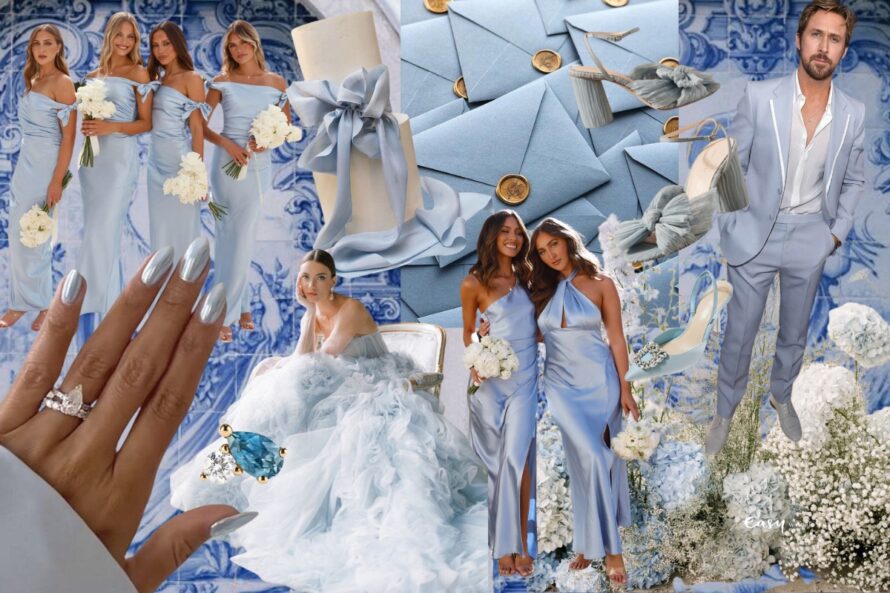Decode the wedding dress code: what do they actually mean?
Once the wedding date has been set and the aesthetic has been chosen, many couples opt to send out their wedding invitations with a dress code for their day— code being the operative word! If you’ve ever received a text from a fellow wedding invitee saying something like, “Help! What on earth does ‘garden formal’ mean?!” then you’ll know what we’re talking about.
So, what happens if you’re left desperately sifting through your closet after finding yourself on the receiving a cryptic dress code? Or, if you’re planning your wedding and aren’t entirely sure what’s going to suit (pun intended) the big day?
Never fear. We had a chat with three specialist formal wear suppliers to give you all of the dress code information you need to dress for success at any wedding.
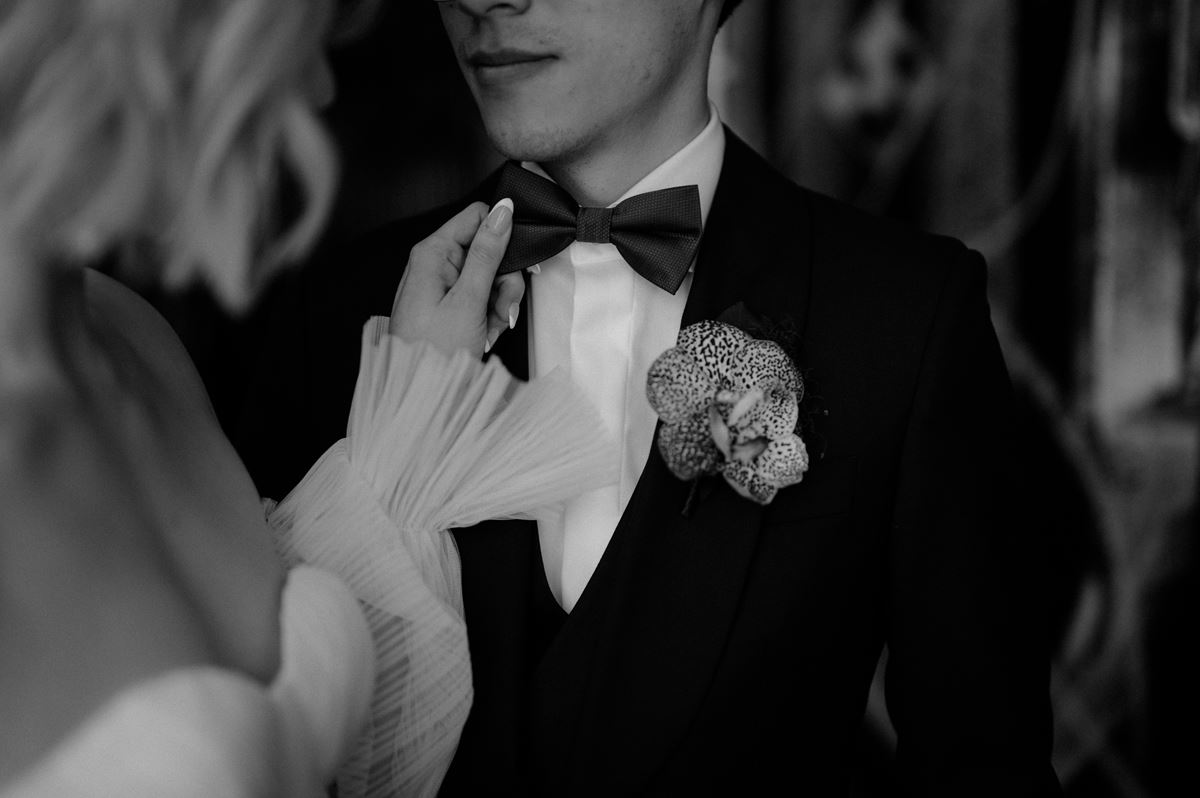
Black tie, bow tie, no tie: what’s the difference? | The Farm Yarra Valley
Why should I include a dress code on my wedding invitation?
You might think it’s obvious what kind of attire you should wear to a wedding. In an ideal world, everyone would just “get” it. Your guests would read your mind and show-up in stylish attire that perfectly complements your wedding aesthetic. In reality, a dress code is your best shot of encouraging a cohesive look for your guests.
Including a dress code for your guests is a great way to enhance the tone, theme or mood you want for your wedding. Not only can it help streamline the look you’re going for by having your guests dress according to your overall wedding style, but it also gives your guest’s peace of mind by knowing what they should wear!
“No one likes to appear at any event under or overdressed,” says Tracey from Ferrari Formalwear & Bridal.
“This is one of the reasons it’s so important to understand the meaning of the different dress codes, so you can state your request wisely for your guests.”
“For us, dress codes do set a tone for the wedding,” says Roshni from Bentex Suits.
“Two of the most important factors to consider while setting a dress code have to be the season and the venue. If the couple is getting married by the beach then the dress code should be more relaxed. Let the venue and season dictate the dress code for the wedding party as well as the guests.”
“We always recommend including a dress code for your wedding so that guests have a guide as to the formality,” adds Tim from InStitchu.
“Naturally, you should also consider the location, climate and the level of formality you want for your wedding. Otherwise, you run the risk of a very wide variety of tuxedos, chinos and the odd pair of jeans. We suggest either black tie, cocktail or smart casual.”
While dress codes can provide guidance for each style, the definition of different dress codes has changed over time. Modern couples and their guests are much more relaxed when it comes to dress codes, which is why we’re seeing more ‘casual’ formalwear options come in for couples.
“We have seen a rise in the number of ‘relaxed’ style weddings taking place,” Tracey says. “This does not, however, mean shorts and thongs! Relaxed suiting is lightweight, supple and easy to wear. Think natural colours and fabrics, patterned sports jackets, colourful accents and statement accessories.”
So, now we know why it’s important to give a guide to your wedding dress code, what are the various dress codes and what do they mean?

Why should we set a dress code? | Ferrari Formalwear and Bridal
Smart casual
“Smart casual is defined as conventional, neat and relatively informal style,” says Roshni from Bentex Suits.
A smart casual dress code is great for your guests as it provides guidance while also giving them a lot of options. Guests have a wide scope of clothing choices that are smart, without being overly dressy, or overly casual.
Roshni adds: “For us, a smart casual dress code should be about a well-tailored jacket, shirt and dark pair of chinos or trousers. You could opt for a fitted suit – trousers and jacket in one colour, but we recommend you ditch the tie/bow tie for a more relaxed look.”
For women, a smart casual dress code could be anything from a neat tailor blazer, a sundress or even a jumpsuit. Classic skirts and of course that little black dress will also be suitable.
The smart casual dress code is a good go-to for weddings with an outdoor feel, such as beach, garden or boho themes. Some couples also opt for a smart casual look with more relaxed rustic weddings, however, Roshni does have one more piece of advice.
“One tip we would like to share with you all is to make sure your shoes tie in the ensemble together. They have to sing the same tune as your outfit. For a smart casual look go with tan boat shoes and no socks!”

Get quirky with some offbeat socks for smart casual attire | DUUET Photography
Cocktail
The cocktail dress code is one step up from smart casual and is a little more dressy, while still having that informal feel.
“Cocktail is the most popular of all formal dress codes,” says Tracey from Ferrari Formalwear & Bridal.
“It’s still formal but leaves a little more room for creativity. While there are no strict rules, cocktail generally means a jacket and tie. Then you can go as far as you want – black or grey trousers with a velvet jacket or a suit.”
Bow ties, traditionally black or white, have also become popular within cocktail style dressing. Often bow ties can be used to add personality to an otherwise conventional get-up: think quirky quirky prints or a pop of colour.
Traditionally, cocktail attire for women was restricted to dresses that were knee-length. However, as dress codes become more modern any length shorter than an evening dress, as well as other items such as jumpsuits, may be appropriate for a cocktail wedding.
A good rule of thumb to ensure you stay within a cocktail dress code is to balance your the cut and fabric of your attire. If you’re opting for a shorter or less structured dress, a dressier fabric (think velvet or satin is an excellent choice). Should you be looking for a jumpsuit or another floor length number, an understated fabric will stop you from appearing overdressed.
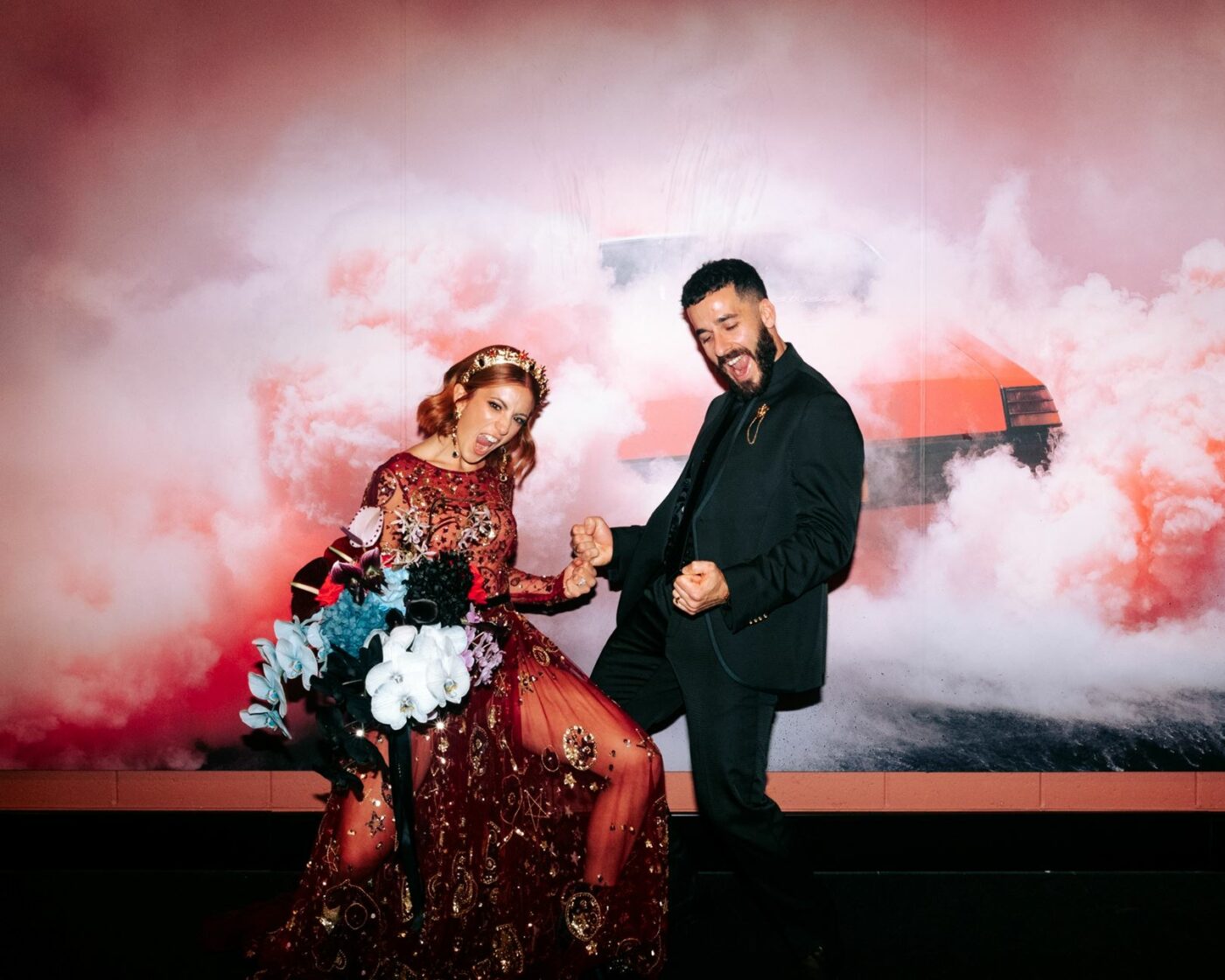
Have some fun with cocktail dress | QT Perth
Jacket and tie
Now that we’re getting into the jacket and tie look, things are getting a bit more formal. The jacket and tie look is slightly more formal than a cocktail dress code (where the tie is optional), and can actually be quite similar to the lounge suit look.
“We always love to add a tie, as we think it adds another level of formality and respect as well as an opportunity to play with colours/patterns of texture,” says Tim from InStitchu.
“Depending on the formality, if you are wearing a pair of cotton chinos, an oxford shirt and a casual, deconstructed blazer, opt for a knitted tie to keep the formality at the same level.”
“You don’t want to wear your Monday business tie with chinos, it just doesn’t quite look or feel right.”

Jacket + tie means you can play with textures and colours | The Farm Yarra Valley
Lounge suit
The lounge suit dress code is a traditional British way of describing a suit and is more directed towards men rather than women. Nowadays, it can be quite similar to the jacket and tie look and is favoured by most weddings looking for a classic dress code.
“A lounge suit is just another way to say a suit that has matching trousers and jacket,” explains Tim from InStitchu.
“For warmer months, you could opt for a linen or cotton blend to be more appropriate for the Australian climate. Or for the cooler months, either a lightweight flannel or heavier worsted wool. The dress code should mention a lounge suit, but for a smart casual look, you can get away with a lounge suit as well. Just lose the tie.”
“The lounge suit dress code is also very similar to a cocktail dress code,” adds Tracey from Ferrari Formalwear & Bridal. “You can keep things simple or spice things up by mixing your pants with a textured jacket. From there you can add extras to dress things up or down – think tiepin, pocket square, bow tie, a pair of cuff links. The versatility is endless with a lounge suit.”

Groom Sharif in a navy lounge suit – see the Real Wedding here.
Morning suit
Fancy a little royal glam for your wedding? The morning suit is one of the most traditional dress codes and is typically directed towards male members of the wedding party, rather than guests. It’s suited to very formal weddings and is often seen more during royal weddings than regular weddings. Perhaps you’d see it on an episode of Made in Chelsea, it has an air of aristocracy.
Men should opt for a tailcoat, waistcoat, and striped trousers, while women should wear a very formal daytime dress with a hat. Traditionally, morning suit was the only dress code for weddings beginning before 4:30pm, hence its name.
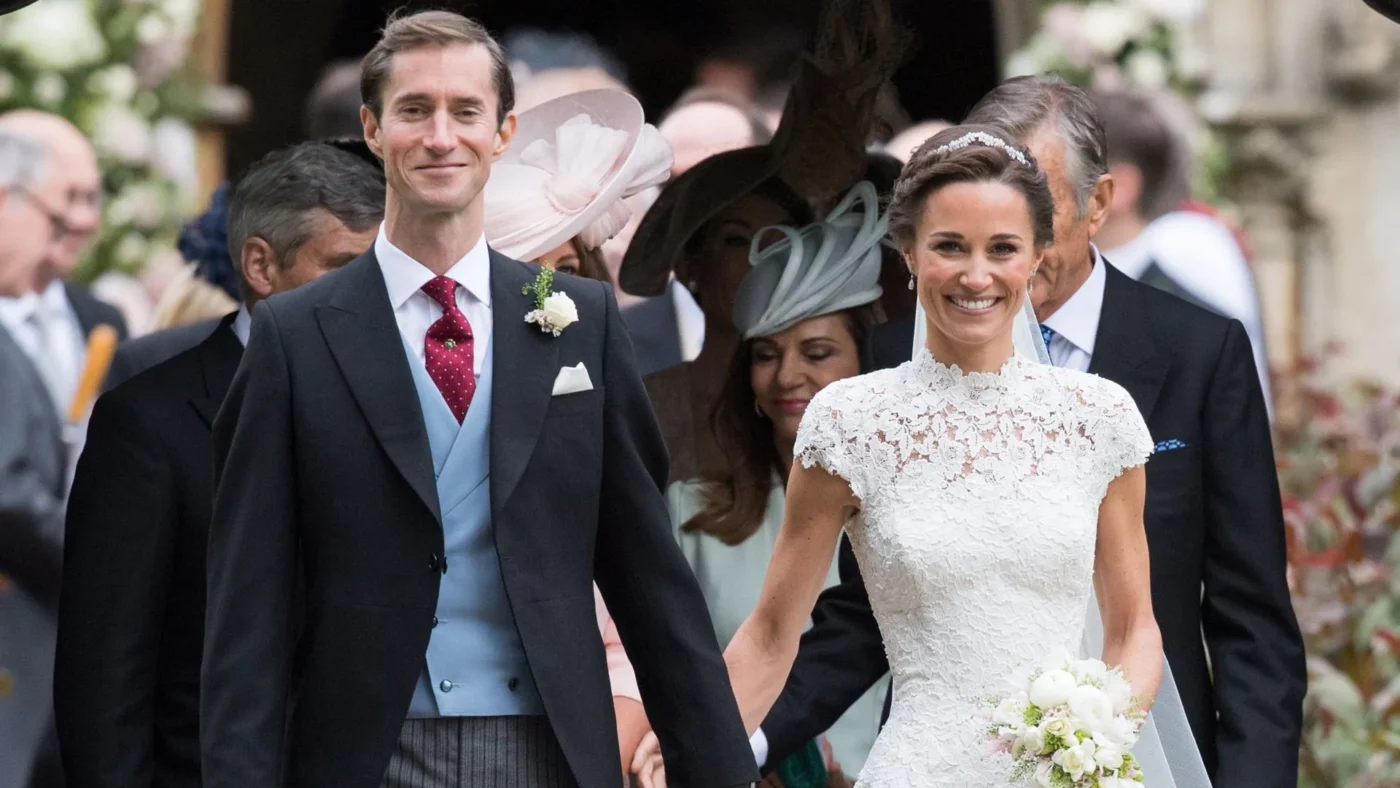
It’s very black tie | Getty images
Black tie vs black tie optional
The black tie dress code is the second most formal dress code and is typically reserved for nighttime weddings, particularly those with an elegant, luxurious or modern theme.
For women, a black tie event dress code means opting for an evening gown, though this can be of any colour.
As Tracey from Ferrari Formalwear & Bridal says, the black tie dress code is “crystal clear” for men. ” Wear a tuxedo and a bow tie!”
“The tradition of wearing a luxurious tuxedo is a rite of passage for any man,” says Tracey. “After all, there’s nothing quite like wearing a well-tailored suit to an elegant black tie event.”
“The traditional black tie tuxedo has satin lapels, accompanied with a vest. The classic look involves a shirt with a pleated front, button studs and a black bow tie, white pocket square and pair of black shoes complete the look. Wear a black tux with black patent lace-up shoes and you can’t really go wrong.”
You might also see the dress code black tie optional, which is one step down from the formal black tie dress code and gives guests a little more room to move. Tracey explains:
“A dark suit is still expected and more commonly worn at these events, however these days, unless you’re going to a seriously traditional event, you can get away with many variations on this theme.”
“In place of a tuxedo, your slim-fitting dark blue or black suit can be worn buttoned up with a bow tie and white pocket square. In fact, if an event says ‘black tie optional’, this is what many men will choose to wear.”
“If in doubt, we say to channel James Bond!”

Bow tie or no bow tie? | InStitchu
Formal
The formal dress code also comes in somewhere between the lounge suit and a black tie event.
For the ladies, this could be either a short or long formal dress, pantsuit, or dressy jumpsuit or separates.
For men, there are a few options and choices, according to Roshni from Bentex Suits.
“You could dress in a well-fitted suit and shirt, you take the look a notch up and add individual flair with a contrasting vest and a tie or bow tie.”
“If the venue is a ballroom or more formal, then the couple could even opt for a black-tie optional dress code for the guests. Which means the guest should wear a dark colour suit or they can make a statement in a tuxedo.”
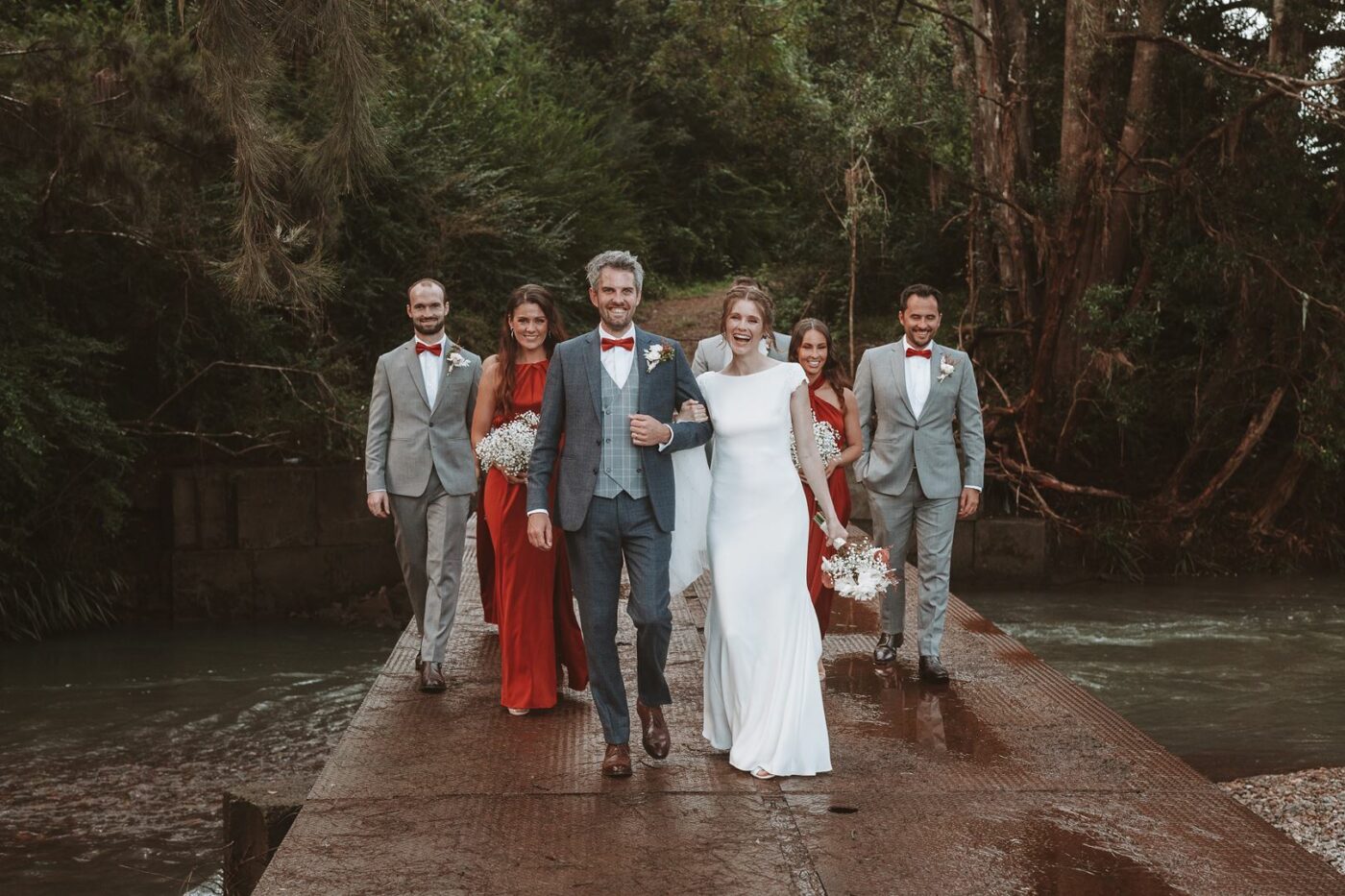
There’s many options for suits, ties and dress codes! | Bentex Suits
White tie
“While white tie is not as popular these days, this is the most formal of all dress codes,” says Tracey from Ferrari Formalwear & Bridal.
“A tail suit should always be worn along with a white vest, bow tie and a pocket square. You can finish your look by accessorising with a top hat and cane if you are going seriously traditional.”
For women, the white tie dress code involves a ball gown, while evening gloves and tiaras can also traditionally be worn. This is another dress code that is often worn by royals, celebrities, politicians, or at large charity balls.
Can I be less specific about the dress code?
So, what if you don’t want to tell your guests what you want them to wear? Can you be less specific about your wedding dress code?
“Yes, absolutely, why not?” says Roshni from Bentex Suits. “It’s absolutely up to the couple to take a call if they want the guests to follow a certain dress code or they just dress to impress.”
Bear in mind though, even if you don’t set a dress code, it’s good to tell a few close friends and family members what you expect in terms of what people can wear. There will always be some guests who do want guidance for how they can dress to the appropriate level. Delegate to your family and friends to avoid having to answer questions about the dress code in the lead up to your big day!
What do I do if people ignore the dress code?
It’s highly unlikely that your friends and family will deliberately fly in the face of your dress code. Perhaps your uncle doesn’t know the difference between cocktail and formal. Or your brother’s new girlfriend selected a dress that’s more “Saturday night at the club” than black tie. It’s important to keep these things in perspective, and remember that people are doing their best.
Ultimately, it’s up to you what you want to do it someone ignores the dress code. Having invited them to your wedding, we know you’re unlikely to send someone home because they chose to wear the wrong thing.
“If, as a couple you are pretty set on ensuring that everyone adheres to the dress code you have chosen, just be sure to be very specific in your dress code request on your invitations,” says Tracey from Ferrari Formalwear & Bridal.
For example, if your venue has a formal dress code that you must adhere to, stating this on your invitations could be a good way of making sure all your guests know exactly what is expected of them.
“There is nothing wrong with saying, for example, ‘dress code formal’ and then spelling it out on your invitation. ‘Gentlemen please wear a formal suit’.”
“We often have couples request some store business cards to pop into their invitations to prompt their guests to make an effort to buy or hire a suit to wear to their special occasion.”

